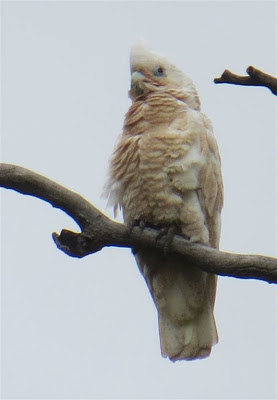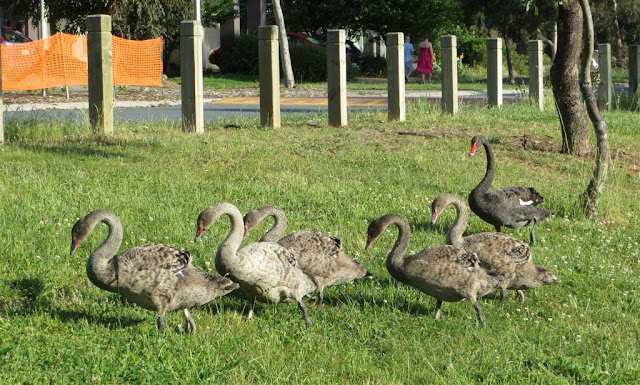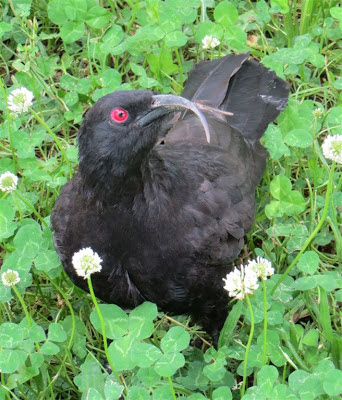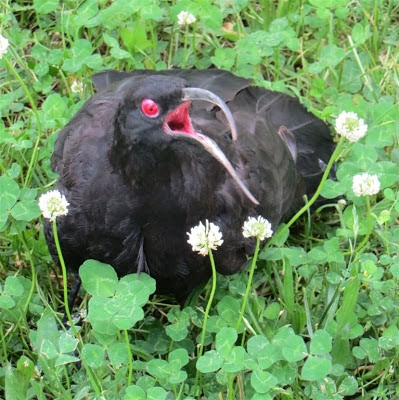And some bonus pictures.
This blog is to share my photographs of, and enthusiasm for, the native birds living around and passing by the base of Mount Majura, Canberra, Australia. It was inspired by the swanlings at the bottom of my street. All photographs have been taken on local walks.
Tuesday 27 November 2012
Feeding time at the zoo
The five swanlings continue to thrive. At 3 - 3/1/2 months old they are about 2/3 the size of their parents. The feed on this occasion consisted of handfuls of clover which satisfied the swanlings, though the parents were on the lookout for Bakers Delight treats.
And some bonus pictures.
And some bonus pictures.
Monday 26 November 2012
Hitchin' a ride
# 1 A Common Myna taking a Sunday ride.
# 2 Gum Tree Hollows, currently home to a bunch of mynas. This was undoubtedly once home to native birds, now evicted/displaced. Not ideal.
But wait, it's not all bad news. There's a group in Canberra who work to protect native birds from mynas.
http://www.indianmynaaction.org.au/
Read about their success:
The success of our collective efforts is easily noticed by the drastically reduced numbers of mynas that we see and hear. Again the Canberra Ornithologists Group’s 2009 Garden Bird Survey Annual Report that was released in Nov 2009 records the drop-off in myna numbers: mynas are now the 14th most common bird in Canberra whereas they were the 3rd most common when we started 4 years ago. This is a wonderful achievement — and one that all our 1020 CIMAG members and 800 trappers can be proud of.
How fantastic to discover such a group exists.
# 2 Gum Tree Hollows, currently home to a bunch of mynas. This was undoubtedly once home to native birds, now evicted/displaced. Not ideal.
But wait, it's not all bad news. There's a group in Canberra who work to protect native birds from mynas.
http://www.indianmynaaction.org.au/
Read about their success:
The success of our collective efforts is easily noticed by the drastically reduced numbers of mynas that we see and hear. Again the Canberra Ornithologists Group’s 2009 Garden Bird Survey Annual Report that was released in Nov 2009 records the drop-off in myna numbers: mynas are now the 14th most common bird in Canberra whereas they were the 3rd most common when we started 4 years ago. This is a wonderful achievement — and one that all our 1020 CIMAG members and 800 trappers can be proud of.
How fantastic to discover such a group exists.
Sunday 25 November 2012
Baillon's Crake
Pretty exciting to have a Baillon's Crake show up at the local pond! I've never seen one before today. The pictures are from this morning. The crake was still loitering in the same patch in the late afternoon when I walked by again. It's chosen a fairly public reed bed right now, next to swan feeding centrale. I hope it finds a quieter section of reeds and decides to stick around.
Thursday 22 November 2012
Swanling in the grass
Swanlings at three months spend a lot of time sitting at the edge of the reeds. Their camouflage is a real advantage at this age, while they are still vulnerable.
Australian White Ibis
The local pond provides an opportune port of call for many birds passing through this area. This morning three ibis popped in for a while. They are really quite cute in the wild. The white ibis that live in city parks will snitch your sushi 'n fries, without a second glance. Consider yourself warned.
Sunday 18 November 2012
Passer Domesticus
What kind of person brings a House Sparrow all the way to Australia in the 1860s? That's late in terms of settlement. Europeans had been headed here for about 80 years by then so it wasn't as if sending sparrows was a high priority. And sparrows couldn't have stowed away like rats and cockroaches. Someone had to keep them alive for months, aboard a ship. Someone really cared. Someone really wanted sparrows in Australia. And clearly that someone hadn't factored all the fab birds already here, that make for way better birdwatching. What kind of thinking is this?
Much to the embarrassment of my husband, I photographed this sparrow at the Farmers Markets on the weekend and decided the local Farmers Markets are now within my Majura Range. It's a destination I walk to regularly so why not? Chatting to the cherry sellers I asked about their season. Light, they said, because of rain. What about native birds attacking the crop? I asked casually. Yes big problem. We can't do anything about them, and sparrows too.
SPARROWS!
Reference for dating entry of sparrows to Oz,
Much to the embarrassment of my husband, I photographed this sparrow at the Farmers Markets on the weekend and decided the local Farmers Markets are now within my Majura Range. It's a destination I walk to regularly so why not? Chatting to the cherry sellers I asked about their season. Light, they said, because of rain. What about native birds attacking the crop? I asked casually. Yes big problem. We can't do anything about them, and sparrows too.
SPARROWS!
Reference for dating entry of sparrows to Oz,
Saturday 17 November 2012
Corellas in the mist..
So these Little Corellas added some x factor to the morning. What a great sight, to look up and see so many. And so calm! The last corellas I saw were edgy.
Anyhow the plot thickens. Just a few minutes earlier I'd seen what I thought was a flock of Sulphur-crested Cockatoos. I assumed they were cockatoos because we have plenty around here and from below they looked like cockatoos and also because they sounded like cockatoos, (if slightly less corrosive) and also because I was attempting to jog and wasn't imagining corellas. In retrospect I'm wondering if that flock were actually corellas and these are some of them.
This is a washed out photograph (it was misty y'know!) but I'm posting it to show how filthy this corella is. I'll be betting a farmer somewhere in the Murray Darling Basin is mad as a hatter at these birds.
Little Black Cormorant
This morning was the the first time I've noticed a Little Black Cormorant at the pond. It's amazing how many birds take turns to sit on that chunk of tree. The designer who came up with the idea of tossing old trees into ponds, really knows what birds like.
Thursday 15 November 2012
When the going gets tough, the tough get going
Walking home by the pond the other afternoon, I was excited to see a second long-necked turtle, smaller than the one I have previously posted about.
When lo, the turtle I've seen previously also emerged from the murky depths.
Two turtles was too close for comfort for the black ducks. It was time to find a less cramped location.
Just how do these turtles find the pond?
When lo, the turtle I've seen previously also emerged from the murky depths.
Two turtles was too close for comfort for the black ducks. It was time to find a less cramped location.
Just how do these turtles find the pond?
Monday 12 November 2012
Willie Wagtail
Sunday 11 November 2012
Juvenile birds
One of the great things about walking around right now is all the juvenile birds out exploring their world. This post is dedicated to LOL, not exactly a juvenile herself... but definitely young at heart! Her Aussie spring birthday just passed. Happy birthday.
These swallows fledged over the weekend. For weeks I been seeing Welcome Swallows taking food into the big cement pipe that feeds the pond. Highly inaccessible for humans, I never saw their nest, but today - several new mini swallows!
If you read my post yesterday about White-winged Choughs you might recognise this bird. Yesterday nestling, today fledgeling! Although it seems the big trip to the ground tuckered this one out.
These fledgeling/juvenile birds are very relaxed. It's the mature birds who are wary of potential dangers. Certainly the mature choughs were eager to get this one on its feet rapidly. You can see one of them, in the next picture with its wings spread, urging the young one into action. I'm guessing the mature bird is trying to appear ferocious and ward off predators, but maybe there's another reason for this performance.
 |
| Juvenile Red Wattlebird |
 |
| Juvenile Welcome Swallow |
These swallows fledged over the weekend. For weeks I been seeing Welcome Swallows taking food into the big cement pipe that feeds the pond. Highly inaccessible for humans, I never saw their nest, but today - several new mini swallows!
 |
| Juvenile Currawong |
 |
| Fledgeling chough |
If you read my post yesterday about White-winged Choughs you might recognise this bird. Yesterday nestling, today fledgeling! Although it seems the big trip to the ground tuckered this one out.
These fledgeling/juvenile birds are very relaxed. It's the mature birds who are wary of potential dangers. Certainly the mature choughs were eager to get this one on its feet rapidly. You can see one of them, in the next picture with its wings spread, urging the young one into action. I'm guessing the mature bird is trying to appear ferocious and ward off predators, but maybe there's another reason for this performance.
It's definitely Gang-gang season
This morning about eight Gang-gangs flew overhead on Mount Majura, stopping briefly on a very old gum tree. I'm pretty sure this is a juvenile male.
One of the nice birding surprises recently has been discovering Gang-gangs close to home. Later in the day I also saw another pair at Lyneham wetlands, high in a tree, screeching the place down - well it was the male making the racket, but that is not strictly in my Majura birding area. I just love the Gang-gang calling/screeching (as well as other black cockatoos), always reminding me how ancient Australia is.
One of the nice birding surprises recently has been discovering Gang-gangs close to home. Later in the day I also saw another pair at Lyneham wetlands, high in a tree, screeching the place down - well it was the male making the racket, but that is not strictly in my Majura birding area. I just love the Gang-gang calling/screeching (as well as other black cockatoos), always reminding me how ancient Australia is.
Saturday 10 November 2012
Swan promenade
At approximately 3 months of age the swanlings still stay close to each other and both parents when they are out of the water.
And just after this photo was taken, a massive dog walked past. Papa swan has hackles raised or whatever the swan equivalent is. He looks truly impressive. I backed away at that point, lemme tell you.
And now for a brief swanling update: How cool are these wings? Yes I'd flap them too if especially if I'd only just grown them in the last three weeks.
And here's a view of the feather development from the front. Click the picture to see the larger view.
And just after this photo was taken, a massive dog walked past. Papa swan has hackles raised or whatever the swan equivalent is. He looks truly impressive. I backed away at that point, lemme tell you.
And now for a brief swanling update: How cool are these wings? Yes I'd flap them too if especially if I'd only just grown them in the last three weeks.
And here's a view of the feather development from the front. Click the picture to see the larger view.
White-winged Choughs revisited
The bird photographer often finds themselves the subject of the gaze of birds (aka human/bird staring competition) and those who approach birds should also be prepared to be approached by birds. Even if it is a bit scary! This morning these choughs (pictured) raced along the wooden post towards me and I was convinced they were about to clamber onto me. They were Really close. I was the one to back away.
This group of choughs live next to the grounds of a primary school. From what happened this morning, I think they've learnt that people (or school students at least) are potential sources of sandwich etc and it being Saturday, no school, they were overdue for morning tea. Once they figured out I brought no offerings, they wandered off.
This is the same group of choughs who featured in my October post, and I saw the same bird with the malaligned and grossly long beak again today, so it is surviving adequately.
This group of choughs live next to the grounds of a primary school. From what happened this morning, I think they've learnt that people (or school students at least) are potential sources of sandwich etc and it being Saturday, no school, they were overdue for morning tea. Once they figured out I brought no offerings, they wandered off.
This is the same group of choughs who featured in my October post, and I saw the same bird with the malaligned and grossly long beak again today, so it is surviving adequately.
This time I was able to see that just one bird was affected this way.
And if you are interested, here's the nest, complete with one bubba chough, that I affectionately refer to as a 'choughling', and one mature chough delivering an insect. I'm not sure how many of the choughs feed the nestling, but they give the appearance of a high staff ratio for childcare arrangements.
Australian King Parrot
Before I started looking closely at the birds in my area last month, I would have predicted that I'd see as many King Parrots as Crimson and Eastern Rosellas. This has not been borne out. Those other birds are much more commonly seen. In October I saw a group of King Parrots just once; early one morning, in bushland and no others till today, so it was nice to see four King Parrots feeding on plums this morning. This female was so content, she did not budge even when a couple on bikes with two dogs, also stopped to look and chat.
Tuesday 6 November 2012
White-faced Heron
Highly unpopular around the bird traps, this heron was flushed from any pond vantage point by miners, magpies, rosellas and galahs. They really didn't want it hanging around. I think this bird is a juvenile. In the past herons have passed through the pond with much less cacaphony.
Birds of a feather dive together
A parent and almost 3 month old swanling. I've come to the conclusion that swans spend very little time in classic postures.
Racing Pigeon
My second post on non native birds, this pigeon was just too likeable to ignore. A very confident bird, it took no nonsense from hissing swans, or the world record number of photographers mulling about the pond (yes there were two!) All it wanted was a drink of water, which it got after slowly climbing down the logs to reach the water. I got the impression drinks usually come easier.
Even with the aid of google images I'm still not really sure what this bird is, but my best guess is red racing pigeon. This pigeon was a little larger than most feral pigeons and it registered as well fed, well cared for and used to people though I didn't get close enough to read the band. A fine looking bird, for a pigeon.
Even with the aid of google images I'm still not really sure what this bird is, but my best guess is red racing pigeon. This pigeon was a little larger than most feral pigeons and it registered as well fed, well cared for and used to people though I didn't get close enough to read the band. A fine looking bird, for a pigeon.
Subscribe to:
Posts (Atom)






























.jpg)















